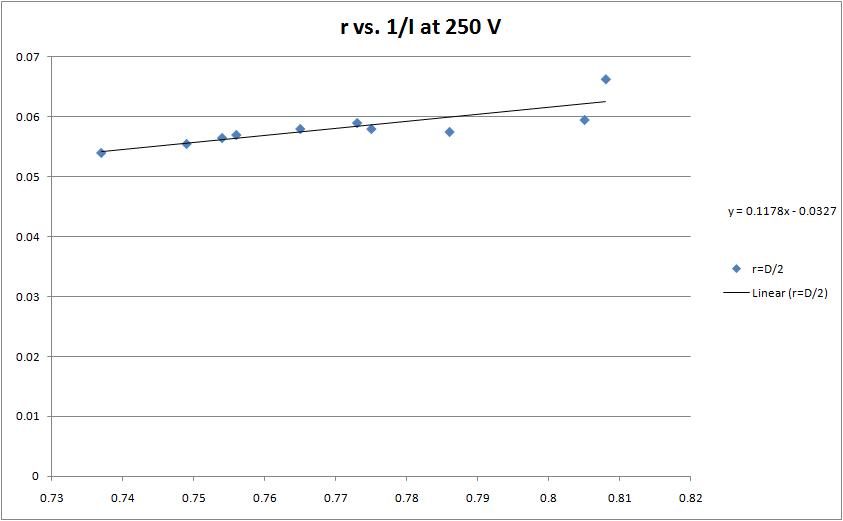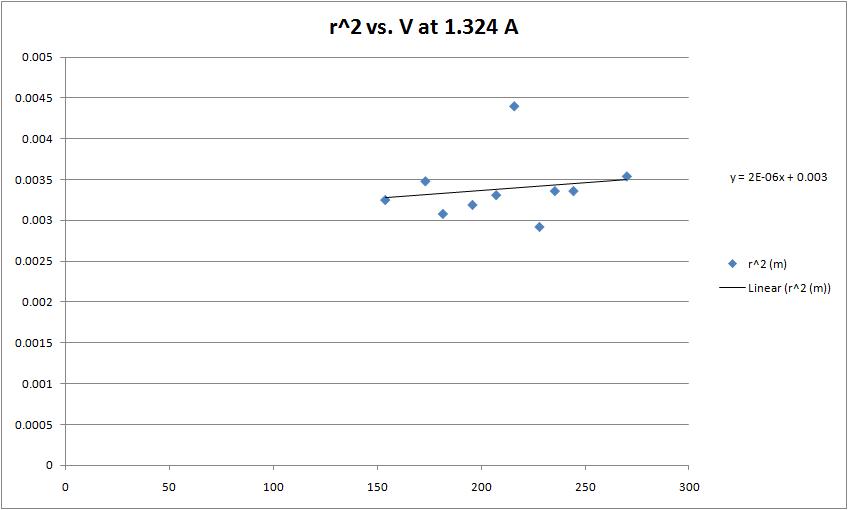User:Cristhian Carrillo/Notebook/Physics 307L/2010/11/10
From OpenWetWare
Jump to navigationJump to search
e/m Ratio
- Please note that Ginny was my lab partner for this lab.
Purpose
The purpose of this lab is to measure the charge-to-mass ratio of the electron by studying the effects of electric and magnetic fields on a charged particle.
Equipment
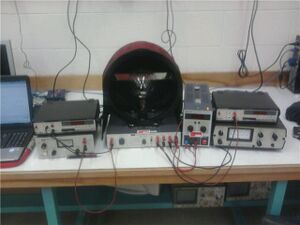
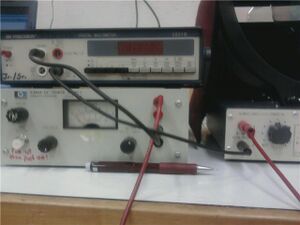
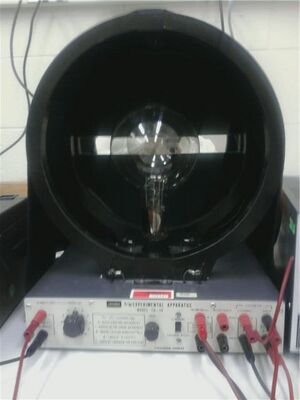
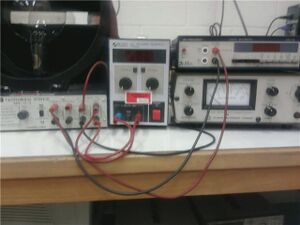
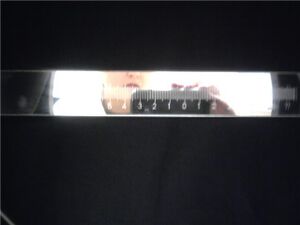
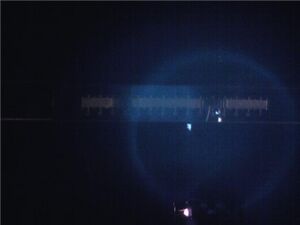
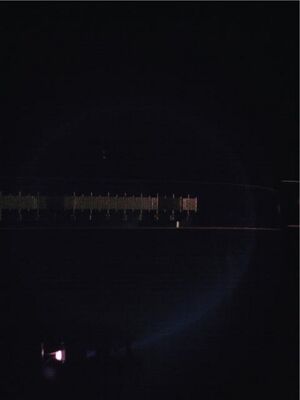
- Hewlett Packard DC Power Supply (Model 6384A, 4-5.5V, 0-8A)
- e/m experimental apparatus (Model TG-13)
- SOAR corporation DC Power Supply (Model 7403, 0-36V, 3A)
- Gelman Instrument Company Deluxe Regulated Power Supply (500V, 100mA)
- 2 BK Precision Digital Multimeter (Model 2831B)
Safety
- Make sure to ground all power supplies properly before use
- Check cords, cables and machinery for any possible electrocution points on fuses of cords
- Protective grounding conductor must be connected to ground
- Be careful with the mercury tube
Setup
- We followed the descriptions in Professor Gold's manual and Alex Andrego's Notebook for the setup.
- Below are the steps we followed to setup the experiment
- We first used BNC cables to conncect a regulated 6-9V DC supply rated at 2A to the Helmholtz Coil jacks.
- Connected the ammeter in series between the supply and the coil jacks.
- We connected the 6.3V power supply rated at 1.5 A to the heater jacks of the electron gun.
- Connected a high voltage source at 150-300V DC rated at 40mA to the electrode jacks of the electron gun
- Please note that the voltage determines the average velocity of the electron in the beam.
- We then connected the DC voltmeter at the jacks labeled "voltmeter" on the base panel.
- Be sure to turn the current adjust control to zero and set the switch on the panel to the e/m position.
- Make sure that nothing is connected to the jacks labeled "Deflection Plates" at this time.
- Allowed the electron gun filament to heat up for a few minutes after we turned on the heater supply.
- We then applied a 200V DC potential from the high voltage supply to the electrodes.
- Then we turned off the light to begin the experiment.
- Make sure that a black cloth to cover the tube and to backdrop the beam while observing the beam of electrons.
- We then adjusted the current control until the beam formed a circle by turning on the coil current and increasing the current adjustment control.
- We then used the scale behind the bulb to measure the radius of the loop of the beam.
Calculations and Analysis
Below is our raw data
Error in widget Google Spreadsheet: Unable to load template 'wiki:Google Spreadsheet'
- The following equations were used to calculate the e/m ratio.
- We found the Helmholtz configuration from Professor Gold's Manual to be:
- [math]\displaystyle{ x=R/2\,\! }[/math], [math]\displaystyle{ N=130\,\! }[/math], and [math]\displaystyle{ R=0.15 m\,\! }[/math]
- The permeability of free space is given as
- [math]\displaystyle{ \mu=4\pi\times10^{-7}\frac{weber}{amp-meter}\,\! }[/math]
- From these values we can calculate:
- [math]\displaystyle{ B=\frac{\mu R^2NI}{(R^2+x^2)^{3/2}}\,\! }[/math]
- We know that the energy of the electron is equal to the kinetic energy:
- [math]\displaystyle{ {e}{V}=\frac{1}{2}{m}{v}^{2}\,\! }[/math]
- The magnetic force for a charge is...
- [math]\displaystyle{ {F}_{B}={q}{v}{B}\,\! }[/math]
- The centripetal force is...
- [math]\displaystyle{ {F}_{c}={m}\frac{v^2}{r}\,\! }[/math]
- Finally we set the centripetal force equal to the magnetic force and obtained:
- [math]\displaystyle{ \frac{e}{m}=\frac{{2}{V}}{{r}^{2}}\frac{{(R^2+x^2)}^{3}}{{({u}{R}^{2}{N}{I})}^{2}}\,\! }[/math]
- According to Professor Gold's manual, the current accepted value of [math]\displaystyle{ \frac{e}{m}\,\! }[/math] is:
- [math]\displaystyle{ \frac{e}{m}=1.76\times10^{11}\frac{C}{kg}\,\! }[/math]
Below is the average and SEM that we found using the above equation [math]\displaystyle{ \frac{e}{m} }[/math] we obtained when we set the centripetal force equal to the magnetic force.
- Average
- [math]\displaystyle{ \frac{e}{m}=1.54\times10^{11}\frac{C}{kg} }[/math]
- SEM
- [math]\displaystyle{ \frac{e}{m}=2.62\times10^{9}\frac{C}{kg} }[/math]
- Percent Error
- [math]\displaystyle{ \% error=12.4%\,\! }[/math]
- The other way to find [math]\displaystyle{ \frac{e}{m}\,\! }[/math] is to plot
- [math]\displaystyle{ r\,\! }[/math] vs. [math]\displaystyle{ {I}^{-1}\,\! }[/math], where [math]\displaystyle{ V\,\! }[/math] is constant.
- The other way to find [math]\displaystyle{ \frac{e}{m}\,\! }[/math] is to plot
- [math]\displaystyle{ {r}^{2}\,\! }[/math] vs. [math]\displaystyle{ V\,\! }[/math], where [math]\displaystyle{ I\,\! }[/math] is constant.
- From this graph we have that:
- [math]\displaystyle{ slope=0.000002\frac{m^2}{V}\,\! }[/math]
- We also have that the equation of slope is:
- [math]\displaystyle{ slope=\frac{2}{({7.8\times10^{-4}{I})}^{2}}\times\frac{m}{e}\,\! }[/math]
- Therefore we can calculate the ratio of [math]\displaystyle{ \frac{e}{m}\,\! }[/math] by:
- [math]\displaystyle{ slope=0.000002\frac{m^2}{V}=\frac{2}{({7.8\times10^{-4}{I})}^{2}}\times\frac{m}{e}\,\! }[/math]
- [math]\displaystyle{ \frac{e}{m}=\frac{2}{0.000002\times({7.8\times10^{-4}{I})}^{2}}\,\! }[/math]
- Where,
- [math]\displaystyle{ I=1.324 A\,\! }[/math]
- So we have:
- [math]\displaystyle{ \frac{e}{m}=\frac{2}{0.000002\times({7.8\times10^{-4}\times{1.324})}^{2}}\,\! }[/math]
- [math]\displaystyle{ \simeq9.376\times10^{11}\frac{C}{kg}\,\! }[/math]
- [math]\displaystyle{ \frac{e}{m}=\frac{2}{0.000002\times({7.8\times10^{-4}\times{1.324})}^{2}}\,\! }[/math]
- From this graph we have that:
Discussion on Error
Reasons for our systematic error
- We had to measure the radius of the electron beam by eye using a fixed ruler in the back of the apparatus. This was hard because we had to roughly estimate for each of the measurements.
- Looking at the second graph above, we can clearly see that there was a larger error for the ratio than the first graph.
- Percent Error for the second graph
- [math]\displaystyle{ \% error=\frac{R_{accepted}-R_{measured}}{R_{accepted}} }[/math]
- [math]\displaystyle{ \% error\approx4.33%\,\! }[/math]
- This percent error came out better than I thought it would be, so I assume that the error for the first graph would have been even smaller.
Acknowledgements
- I would like to thank Ginny for the great help with this lab and all the other labs we have worked on.
- I would like to thank Katie for helping us with the setup.
- Alex Andrego and Anastasia Ierides for the great pictures and setup instructions.
